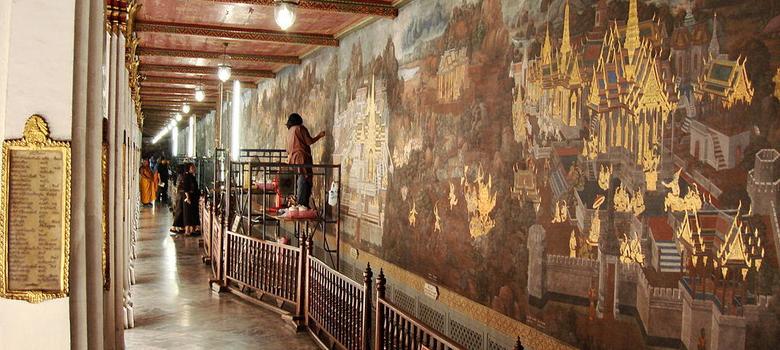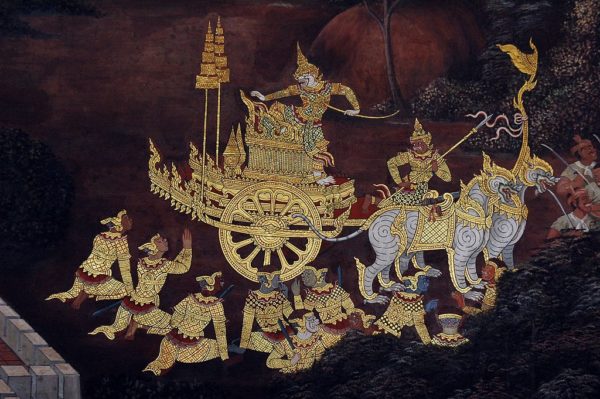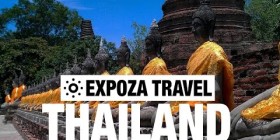
Wat Phra Kaew, or the Temple of the Emerald Buddha, is the most sacred religious structure in Thailand. Located in the heart of Bangkok, near the royal palace, the lavish complex has more than 100 buildings in its compound, including a statue of the Emerald Buddha, which is considered the country’s protector.
Encircling this complex is a two-kilometre-long wall decorated with exquisite murals – of the Ramayana.
The murals of Wat Phra Kaew are sumptuous in colour and delicate in detail. The story of Phra Rama, the hero of Ramakien, as the Thai Ramayana is called, is told across 178 panels that are kept fresh with restorative work every few decades. The latest round was carried out in 2004.
Ramakien, or the Glory of Rama, has the same overarching structure as Valmiki’s version, but differs on some details such as character and setting. Crucially, it is shorn of the religious significance it has in India, and is instead treated as an epic narrative centred on Thai characters.
Phra Kaew, or the Temple of the Emerald Buddha, is the most sacred religious structure in Thailand. Located in the heart of Bangkok, near the royal palace, the lavish complex has more than 100 buildings in its compound, including a statue of the Emerald Buddha, which is considered the country’s protector.
Encircling this complex is a two-kilometre-long wall decorated with exquisite murals – of the Ramayana.
The Monkey Army, aided by the Queen of the Southern Ocean (Guanyin) and her subjects, builds a bridge of stones to Lanka. Photo credit: Wikimedia Commons
The murals of Wat Phra Kaew are sumptuous in colour and delicate in detail. The story of Phra Rama, the hero of Ramakien, as the Thai Ramayana is called, is told across 178 panels that are kept fresh with restorative work every few decades. The latest round was carried out in 2004.
Ramakien, or the Glory of Rama, has the same overarching structure as Valmiki’s version, but differs on some details such as character and setting. Crucially, it is shorn of the religious significance it has in India, and is instead treated as an epic narrative centred on Thai characters.
But how did an iconic Hindu religious epic get to the walls of a Buddhist complex?
The answer lies in the syncretism that is characteristic of much of southeast Asia. The Ramayana reached the region due to its thriving maritime trade with southern India in the first centuries of the Common Era. Hindu merchants first brought the epic – and several aspects of their religion – around 700 CE. As Indian political power waned, so did Hinduism in these countries.
Still, traces remain in cultural if not religious or political ways. In Cambodia, for instance, Brahmins are a traditional part of the coronation ceremony, last performed for a new king 10 years ago. Indonesia, which is a Muslim-majority country, has its famous shadow puppet depictions of the Ramayana. Most people in Thailand, including its ruler, are Buddhists but continue to recognise an 18th century version of the Ramakien as a national epic.
What remains?

There are few surviving versions of the Ramakien in Thailand today. Much documentation of the pre-modern versions of the Ramakien was lost after the Burmese ransacked Ayutthaya, then the Siamese capital, in the mid-18th century. When the Siamese (today’s Thai) eventually regrouped by the end of that century, they had to recreate much of their past.
This is where the oldest existing Thai version of the Ramayana comes in. It was composed as a play between 1797 and 1807 under the supervision of Rama I of the Chakri dynasty that rules Thailand today. It was this version that found its way to the walls of Wat Phra Kaew.
While this version of the Ramayana centres on Hindu gods such as Vishnu and Shiva, it remains a Buddhist retelling, said Frank Reynolds while conducting a comparative study of Hindu and Buddhist Ramayanas.
“The writing of the Ramakien was done in accordance with a traditional tale,” Reynolds quoted Rama I as writing in Ramakien’s epilogue. “It is not of abiding importance; rather, it has been written to be used on celebrative occasions. Those who hear it and see it performed should not be deluded. Rather, they should be mindful of impermanence.”







Leave a reply